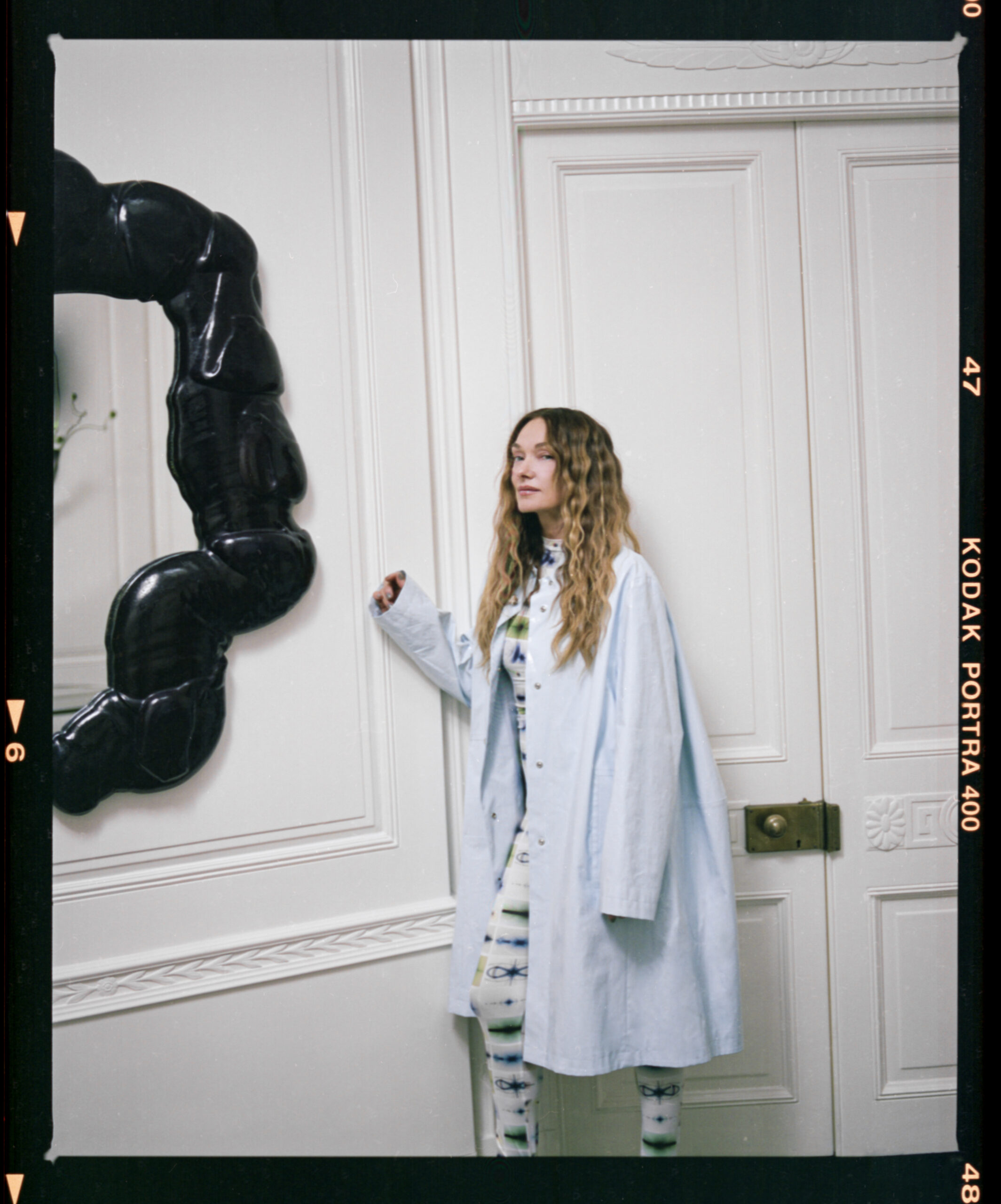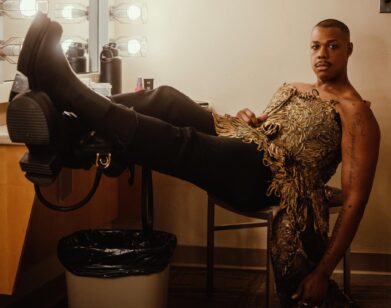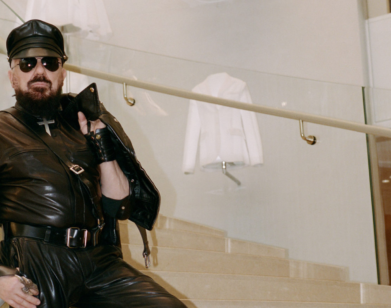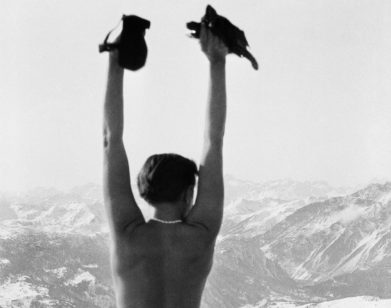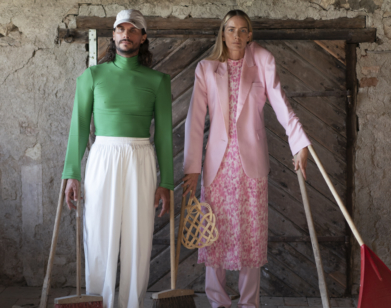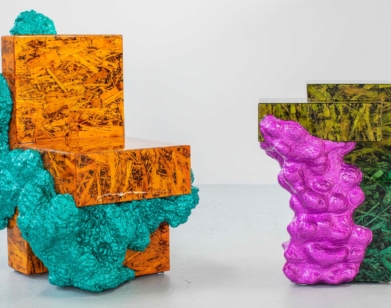in conversation
Kelly Wearstler and Takashi Murakami on Falling in Love and Leaving a Legacy
“Old soul, new spirit,” is the motto for interiors maven Kelly Wearstler. With a star-studded client log, enviably chic style, and six books under her belt, including Synchronicity, her latest tome released last week, the design mogul is not letting up. A few years ago, on a trip to Tokyo, she paid Takashi Murakami a visit at his gallery. “I got a very good feeling from you,” remembered the Japanese artist when he and Wearstler reconnected on Zoom earlier this month, though he didn’t quite understand why she’d elected to talk to him. “I’m a geeky artist and you are very fashionable and trendy,” Murakami noted. But art, Wearstler explained, is all about making people happy, and both artists manage to do so in different ways. So, just before the release of Synchronicity, the two titans of design swapped stories about family, fashion, and falling in love.
———
TAKASHI MURAKAMI: Kelly-san. Thank you for choosing me because I’m a geeky artist and you are very fashionable and trendy.
KELLY WEARSTLER: I love you so much because your work is about making people smile. It’s really optimistic and that’s similar to how I am. Even though our styles are very different, in my business, I’m here to make people happy. And you are fashionable. I remember the first time we met in your gallery in Tokyo and you looked fashionable.
MURAKAMI: I got a very good feeling from you. I want to understand your business as an artist or curator or decorator.
WEARSTLER: I am a multidisciplinary designer. I started with interior design and then we started working on products and architecture. We did residential and we do hospitality and restaurants.
MURAKAMI: For me, I’m an artist, so I make pieces and then I choose the fabricator, computer graphics designer, things like that. How do you find your partners?
WEARSTLER: We seek out artists that can do something very site-specific for each project. When we started doing the hotels, we’d have these unique pieces and people would come in and ask for something similar. So we started partnering with different galleries and artists, and now we have a gallery. That’s where the [title of] my new book coming out is from, which is called Synchronicity. Every project is a massive collaboration. You could have 800 people working on a hotel, from metal workers to electricians to architects and landscape designers, and you have the client. That’s where the name came from, a celebration of collaboration.
MURAKAMI: Although I’ve been working in America, where there are very wealthy clients buying my work, in Japan there aren’t people of that level of wealth who would work with someone like you to coordinate and customize everything for them. So often department stores decorate things for them. But you work with a lot of people who are really high-class. Are there any trends in the realm of beauty with those types of people?
WEARSTLER: I think everyone has their own unique story, so we have to know how to prompt and ask the right questions. If somebody doesn’t necessarily have a super specific point of view, we take them out to museums and galleries to try and extract what’s beautiful to them. But some clients come to the table with the architect they want to use, an art advisor, a landscape designer. It comes in many different packages.
MURAKAMI: After the pandemic, I feel like there’s been a gradual darkness settling in the world. I’ve been creating paintings with darker feelings because I can connect with the audience more in that way. You were talking about how your job is to create happiness and make the atmosphere lighter, yet in the work you do there is some strangeness, or bizarre elements that you wouldn’t just look at and describe as pretty or beautiful. What kind of balance are you looking for?
WEARSTLER: My work is also to find things that have tension and are a little more obscure. I love things that have a lot of soul. We have some clients that want things that are super moody and dark and rich, and that’s what makes it interesting for me. Things are constantly changing, and so is the client’s voice. You have to really read your audience and understand them and be a really good listener.
MURAKAMI: When I first met you at the gallery, I met your wonderful family. You seemed very close with each other. And when we visited your house, your family was there warmly welcoming us. You have such an active career, so how do you manage to be so close with your family? It’s actually morning in Japan and my son wouldn’t go to school. It’s a mystery to me how you have so much time to create a good relationship.
WEARSTLER: Having a routine is so important. And prioritizing. Anytime I travel, I travel with my family. If I have to go to Europe for a client, I go when they’re on spring break or something. And yes, as a working mom there are things that I missed and I’m bummed about it. But one of the beautiful things that came from the pandemic is Zoom meetings, because I have my two older kids and a little baby. Right now I’m at a client’s house in their closet, sitting on the floor doing a meeting with you. So I make my family part of my work. It’s not separate. I want to teach them about pop culture and all the things that make me happy.
MURAKAMI: That’s fantastic because my family doesn’t want to come to my shows.
WEARSTLER: Have you designed an interior?
MURAKAMI: I’ve made small dishes and cups, but no.
WEARSTLER: You should. We have to do something. I think that would be amazing. Would you do that?
MURAKAMI: When I was making a movie, I needed help from the art designer because I’m more focused on a two-dimensional image in my head. The interior is a different talent.
WEARSTLER: But one of the things that’s great about you is that you keep evolving as an artist, like the NFT project. You’re always looking at new mediums. It could be really enlightening taking your work and pushing it into the three-dimensional world. Are you using AI in anything?
MURAKAMI: Yeah, but it’s a kind of routine use. For the new designs, I very casually use the AI, but the final result is not AI stuff.
WEARSTLER: It’s just a tool.
MURAKAMI: Yeah, the ideas came from me. In Japan, creative people hate AI. That’s why I’m hiding that.
WEARSTLER: But it doesn’t take the creative spirit away. I’m using it in my studio in certain departments and I tell everyone that it’s like having a new creative junior person on your team, but that person changes every day. We do very focused studies for things like architectural paneling or millwork. It generates some very interesting ideas.
MURAKAMI: Okay. I have another question about your concept of time. I feel like I can’t coordinate other people’s interior because different kinds of sunlight come in throughout the day. I’d probably think of the whole house and what looks good according to the time of day. What is your relationship with time and how do you place things in the space?
WEARSTLER: That’s a really good question. The architecture is a big component. Sometimes we’re working with a ground-up construction so you have to have a lot of imagination. Even with historic properties, one of the main things that we consider is what’s outside the window, because that is an artwork that’s in the room. What color do the leaves turn at certain seasons? What lighting comes in? If you’re in a city, what does the building look like? Is it a terracotta brick or plaster or stonework? A lot of people don’t think about it, but it’s the window to the soul of the space.
MURAKAMI: Wow. So whenever I see you, you are wearing something very chic and subdued. Some people in a similar field, like Peter Marino, push their own character to almost the forefront of what they do. When you meet a client, how are you thinking about the balance between your own existence and your work?
WEARSTLER: First off, it’s the project and it’s the client. And every project looks very different. But I love fashion and one thing that overlaps with how I dress and how I work is that there’s always something vintage and something new. I love contemporary emerging fashion designers as well as established fashion designers, and it’s the same with the interior. There’s always something vintage and something contemporary. If everything’s new, it’s boring. It’s about having that imperfection and warmth. Old soul, new spirit.
MURAKAMI: Right. I actually just remembered when I was in art university, Japan was in the midst of a bubble economy and I had designed about five restaurants and clubs. So I did design a space, and it was a part-time job designing and building and I enjoyed it a lot. This was a very cheap design, by the way. It’s so embarrassing. But it’s a very complicated line of work and I realized that painting is more suited for me. Was it a straightforward entry into the industry for you, or is there a more complicated history?
WEARSTLER: These are all such great questions. My mom loved going to flea markets and auctions, so she would drag my sister and I with her. I was five years old and so curious to look at the fashion, furniture, old magazines and books, so I was educating my eye unknowingly. Then I went to school in Boston for graphic design and decided I wanted something more three-dimensional, so I started taking classes in architecture and ended up doing interiors. But that’s why my work has color and can be so graphic, because of my love of graphic design. How did you start?
MURAKAMI: My family was very poor and my dad was a taxi driver. I went to a super low-level high school and gave up on life. My classmates were like, 50% Japanese yakuza guys’ sons. One day the teacher asked me about my future and I said I wanted to go to university. Laughing, she said, “Impossible.” So I had to think of how to go to university. I was more likely to make it for drawing or something, so I went to art school. It wasn’t from me choosing my job, it was to escape from Japan.
WEARSTLER: At what point in your career did you feel like you made it?
MURAKAMI: I decided that if I could not become a professional before 30 years old, I have to give up and become a salaryman. So from 22 to 29 years old I tried hard to make it for anything, like the interior design stuff for the club.
WEARSTLER: Are you going to be doing any more collaborations in the fashion world? Because I couldn’t buy the Louis Vuitton bags when they came out.
MURAKAMI: That was with Marc Jacobs [when he was at Louis Vuitton]. Now Louis Vuitton’s president is Pietro Beccari. If he invited me, I’d be very grateful for another collaboration. What about you? Do you do any collaborations?
WEARSTLER: We’ve been doing more collaborations with artists and other brands. I was just in the Netherlands last week because we are constantly curating amazing things for our clients. So I have artists who will be like, “You should go see this other artist. They’re new on the scene.” And all these Dutch emerging designers are insane. I was so blown away. I met with six super young artists, just out of college, and sustainability is a huge factor for them.
MURAKAMI: You have had a pretty long career and no one who’s surviving this long is doing things without thinking about a strategy. What’s the most important strategy that you really protect?
WEARSTLER: The most important thing is loving what I do and staying passionate. And always discovering something new and learning more. Life is about falling in love, and we’re always looking to fall in love with something new, whether it’s art or a person or a plant or anything.
MURAKAMI: I’m sure there must be some kind of standard that makes you fall in love with certain things. So is that something that became natural when you were a child, going to different places with your mom?
WEARSTLER: Yeah, for sure. And my eye is very trained. I know what’s special and I bring those things into the projects. Maybe it’s a little weird, but it’s just something that makes you think.
MURAKAMI: So do you have a big vision for yourself of something you haven’t accomplished yet? I’m 61 and I’ve been thinking about what artists do before they die. For example, Willem de Kooning had Alzheimers, and I love the paintings he made after he had Alzheimers. My father also suffered from Alzheimer’s, so I’m prepared for that possibility and maybe I will create something great. Do you have any big vision for your future?
WEARSTLER: First off, you’re going to live a long life because you are doing something that you love and that’s so important. I just hired someone who worked at Frank Gehry’s studio, he’s 96. He goes to work every day for six hours a day and he loves what he does. But for me, I’m just riding the wave and the most unexpected things happen. Somebody I least expect might call, and that’s what makes it interesting and fun.
MURAKAMI: My last question is about social media. When Instagram came about, I felt it was very suited for posting my artwork. But once the pandemic started, Twitter, or X, was starting to pick up on what I say more, so I’ve been changing my approach for social media. Of course, I follow you on Instagram and see what you’re doing there, and you’re active online. Is this strategic participation or more organic?
WEARSTLER: I love how you’re so open and sensitive. But it’s more organic. It’s just about what’s going on with me and the studio and I incorporate some of my family. I am very involved in it because I think it’s so great to connect with your community.
MURAKAMI: Okay. Thank you so much, Kelly-san.
WEARSTLER: It was amazing. Takashi, you crushed it.
MURAKAMI: I was so nervous.
WEARSTLER: When are you coming to Los Angeles again?
MURAKAMI: I want to come back, but the West Coast is very chilly this year.
WEARSTLER: No, it’s beautiful. We might be doing a project in Tokyo. I’ll keep you posted and you keep me posted. I can have you over for another amazing cheese plate.
MURAKAMI: Thank you so much.
—Translation by Yuko Sakata Burtless

